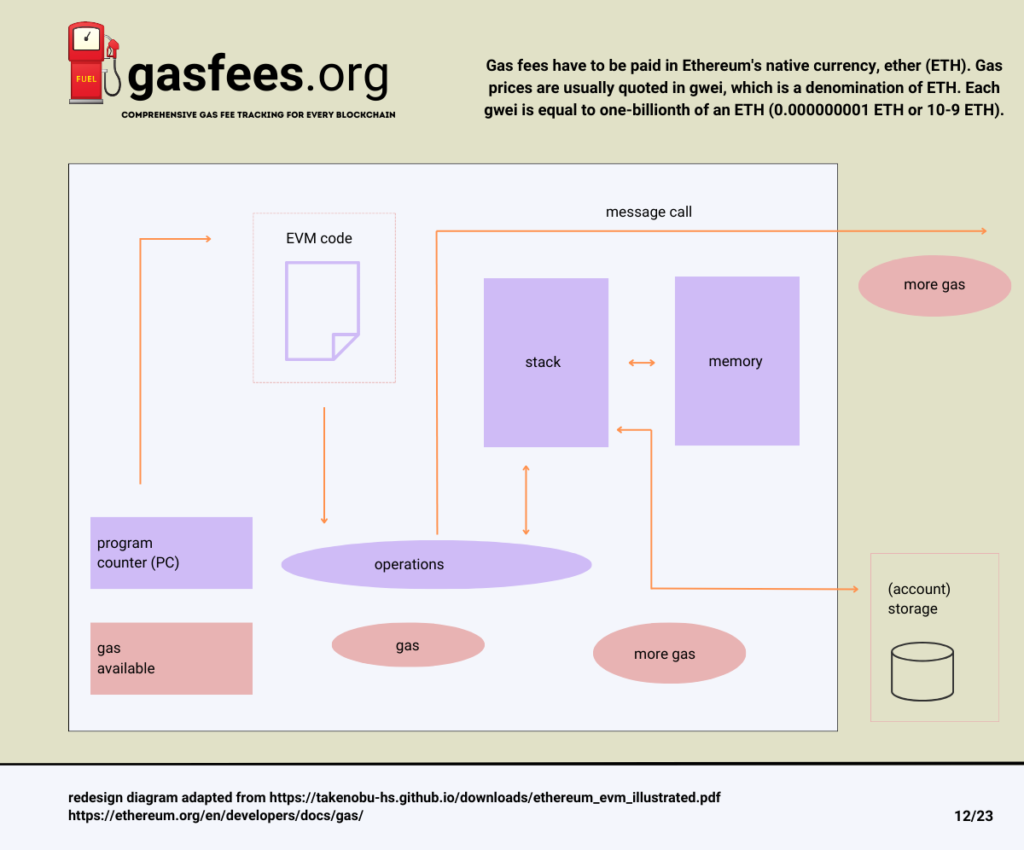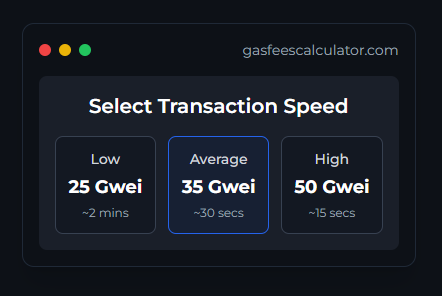
Understanding Ethereum Gas Fees: What You Need to Know
Ethereum, the second-largest blockchain network, has gained immense popularity. However, it’s not without its intricacies. One of the most discussed aspects of Ethereum is its gas fees.
Gas fees are essential for processing transactions and running smart contracts on the network. In this comprehensive guide, we’ll delve deep into Ethereum gas fees, how they work, why they fluctuate, strategies to reduce them, and their impact on the broader blockchain ecosystem. Whether you’re a crypto enthusiast, trader, or DeFi user, understanding Ethereum gas fees is crucial for optimizing your transactions on the Ethereum blockchain.

What Are Ethereum Gas Fees?
Ethereum gas fees are the transaction fees that the Ethereum blockchain charges when you move funds or execute smart contracts. Think of them as the price you pay for using Ethereum’s computational power, much like the fuel you put in your car to make it run smoothly. Gas fees are unique to Ethereum, and users pay for transactions using Ether (ETH), Ethereum’s native cryptocurrency. You can track the current gas price with ether gas tracker.
How Do Gas Fees Work?
To complete any cryptocurrency transaction, you must validate it and add it to the blockchain. Individuals who stake Ether on Ethereum verify these transactions and receive gas fees as a reward for their efforts. The complexity of a transaction determines the fee, with smart contracts and decentralized apps (dApps) typically incurring higher fees. Users can also pay a priority fee (tip) to expedite transaction verification.
The formula for calculating the Total Gas Fee is as follows:
Total Gas Fee = Gas Used * (Base Fee + Priority Fee)
How to Calculate Gas Fees
You can calculate gas fees using a straightforward formula: Total fee = Gas Limit x (Base Fee + Tip). Gas limits vary based on the transaction type, while the base fee fluctuates with supply and demand on the Ethereum network. Understanding this formula helps you estimate transaction costs and prioritize them accordingly.
Factors Affecting Gas Fees
Supply and demand influence Ethereum gas fees. When the network experiences congestion with numerous transaction requests, gas fees rise, and transaction processing can slow down. Conversely, during quieter times, fees tend to be lower. Gas fees are measured in “gwei,” a fraction of Ether, making them more manageable.
Strategies to Reduce Gas Fees
While you cannot avoid gas fees on the Ethereum platform, you can employ several strategies to minimize them and optimize your transactions:
- Be Patient: Waiting for lower traffic times on the Ethereum network can significantly reduce gas fees. Transactions processed during less congested periods often come with lower costs.
- Reduce Your Tip: Consider skipping the priority fee (tip) if you can afford to wait longer for your transaction to process. While tips can expedite verification, they also add to the overall cost.
- Layer 2 Scaling: Explore Layer 2 solutions like Arbitrum, Boba Network, Optimism, and others, which offer off-chain transactions with substantially lower fees. These solutions aim to provide faster and cheaper transactions by processing them outside of the Ethereum mainnet.
- Gas Fee Estimation Tools: Utilize gas fee estimation tools and services that provide real-time data on gas prices and transaction times. These tools can help you make informed decisions about when to send transactions.
- Batching Transactions: Combine multiple transactions into a single batch to reduce gas costs. This approach is especially useful for DeFi users who frequently interact with multiple smart contracts.
- Gas Tokens: Gas tokens like “CHI” can be used to lock in gas prices at lower rates during periods of low network activity and then use them when gas prices are higher, effectively reducing transaction costs.
- Choose the Right Wallet: Some wallets allow customization of gas settings for your transactions. Choosing the right wallet can provide more control over your gas fees.
- Use Optimized Smart Contracts: Developers can optimize their smart contracts to reduce gas consumption, making transactions more cost-efficient.
Why Are Ethereum Gas Prices So Volatile?
Gas prices on Ethereum can be highly volatile due to network congestion. When demand for transactions is high, gas fees increase, and users may need to pay more to prioritize their transactions. This supply-and-demand mechanism keeps the network secure and efficient but can lead to unpredictable fee fluctuations.
Ethereum Gas Prices After The Merge
Despite the recent upgrade known as The Merge, Ethereum gas fees haven’t seen a significant reduction. However, Layer 2 solutions like roll-ups are expected to play a crucial role in lowering gas fees in the future. The Merge transitioned Ethereum from a proof-of-work (PoW) to a proof-of-stake (PoS) consensus mechanism, which was expected to reduce energy consumption and potentially lower gas fees. While it did improve Ethereum’s environmental impact, gas fees have remained volatile.
The Impact of Gas Fees on the Ethereum Ecosystem
Ethereum gas fees play a pivotal role in the broader Ethereum ecosystem, affecting various participants in different ways:
- Users: High gas fees can discourage users from making transactions on the Ethereum network, especially for smaller transactions. This can limit the accessibility and affordability of decentralized applications and services.
- Developers: Developers must consider gas fees when designing smart contracts and dApps. High fees can lead to decreased usage and adoption of their products.
- DeFi Platforms: DeFi platforms heavily rely on Ethereum, and high gas fees can affect the profitability and usability of these platforms. Users may be reluctant to engage in DeFi activities due to the associated costs.
- NFT Marketplaces: Non-fungible token (NFT) marketplaces, which often involve numerous transactions, are particularly sensitive to gas fees. High fees can impact the trading volume of NFTs.
- Ethereum Competitors: High gas fees have driven some users and developers to explore alternative blockchain platforms with lower fees, potentially impacting Ethereum’s market share.
The Future of Ethereum Gas Fees
The Ethereum community is actively working on solutions to address the issue of high gas fees and ensure the long-term scalability of the network. These solutions include:
- Layer 2 Scaling: As mentioned earlier, Layer 2 solutions are becoming increasingly popular. They aim to alleviate congestion on the Ethereum mainnet by processing transactions off-chain or in a more efficient manner, ultimately reducing fees and increasing transaction throughput.
- Ethereum 2.0: The Ethereum 2.0 upgrade, still in progress, promises significant improvements in scalability and sustainability. It will transition Ethereum to a full PoS system, which is expected to further reduce gas fees and energy consumption.
- EIPs and Protocol Upgrades: Ethereum Improvement Proposals (EIPs) regularly introduce changes to the Ethereum protocol to optimize gas usage and enhance efficiency.
- Competition: As other blockchain networks continue to evolve and offer competitive advantages, Ethereum faces pressure to innovate and maintain its position as a leading smart contract platform.
Conclusion
Understanding Ethereum gas fees is vital for anyone involved in cryptocurrency transactions on the Ethereum network. Gas fees are a fundamental part of how Ethereum operates, and being aware of strategies to optimize your transactions can help you save money and make the most of your Ethereum experience.
While gas fees remain a challenge, the Ethereum community is actively working on solutions to make transactions more efficient and cost-effective. Stay informed about gas.
Note: The information provided here is for educational purposes only and should not be considered financial or investment advice. Gas fees and network conditions can change rapidly, so always check the latest data and consult with experts for specific guidance.





